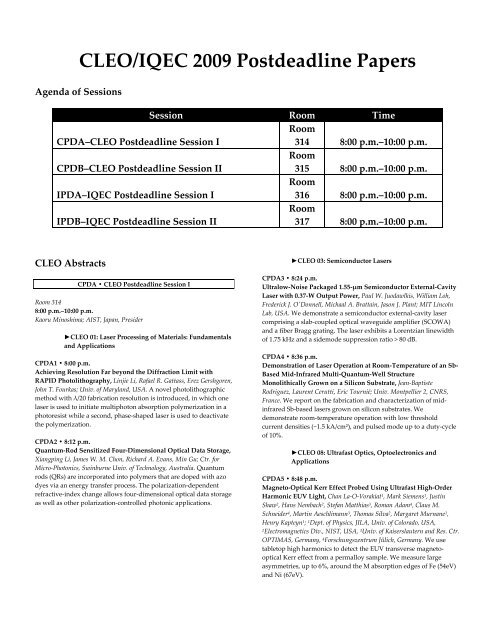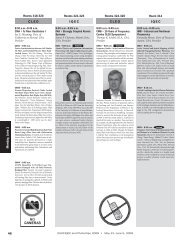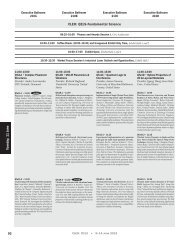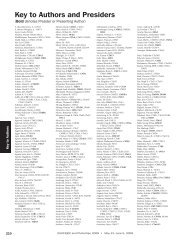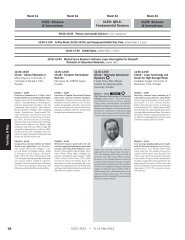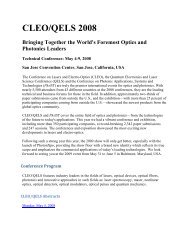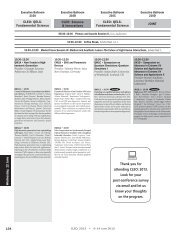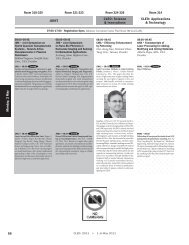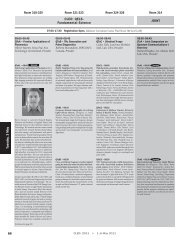Postdeadline Paper Abstracts - CLEO
Postdeadline Paper Abstracts - CLEO
Postdeadline Paper Abstracts - CLEO
You also want an ePaper? Increase the reach of your titles
YUMPU automatically turns print PDFs into web optimized ePapers that Google loves.
<strong>CLEO</strong>/IQEC 2009 <strong>Postdeadline</strong> <strong>Paper</strong>s<br />
Agenda of Sessions<br />
Session Room Time<br />
CPDA–<strong>CLEO</strong> <strong>Postdeadline</strong> Session I<br />
Room<br />
314 8:00 p.m.–10:00 p.m.<br />
CPDB–<strong>CLEO</strong> <strong>Postdeadline</strong> Session II<br />
Room<br />
315 8:00 p.m.–10:00 p.m.<br />
IPDA–IQEC <strong>Postdeadline</strong> Session I<br />
Room<br />
316 8:00 p.m.–10:00 p.m.<br />
IPDB–IQEC <strong>Postdeadline</strong> Session II<br />
Room<br />
317 8:00 p.m.–10:00 p.m.<br />
<strong>CLEO</strong> <strong>Abstracts</strong><br />
CPDA • <strong>CLEO</strong> <strong>Postdeadline</strong> Session I<br />
Room 314<br />
8:00 p.m.–10:00 p.m.<br />
Kaoru Minoshima; AIST, Japan, Presider<br />
►<strong>CLEO</strong> 01: Laser Processing of Materials: Fundamentals<br />
and Applications<br />
CPDA1 • 8:00 p.m.<br />
Achieving Resolution Far beyond the Diffraction Limit with<br />
RAPID Photolithography, Linjie Li, Rafael R. Gattass, Erez Gershgoren,<br />
John T. Fourkas; Univ. of Maryland, USA. A novel photolithographic<br />
method with λ/20 fabrication resolution is introduced, in which one<br />
laser is used to initiate multiphoton absorption polymerization in a<br />
photoresist while a second, phase‐shaped laser is used to deactivate<br />
the polymerization.<br />
CPDA2 • 8:12 p.m.<br />
Quantum‐Rod Sensitized Four‐Dimensional Optical Data Storage,<br />
Xiangping Li, James W. M. Chon, Richard A. Evans, Min Gu; Ctr. for<br />
Micro‐Photonics, Swinburne Univ. of Technology, Australia. Quantum<br />
rods (QRs) are incorporated into polymers that are doped with azo<br />
dyes via an energy transfer process. The polarization‐dependent<br />
refractive‐index change allows four‐dimensional optical data storage<br />
as well as other polarization‐controlled photonic applications.<br />
►<strong>CLEO</strong> 03: Semiconductor Lasers<br />
CPDA3 • 8:24 p.m.<br />
Ultralow‐Noise Packaged 1.55‐μm Semiconductor External‐Cavity<br />
Laser with 0.37‐W Output Power, Paul W. Juodawlkis, William Loh,<br />
Frederick J. OʹDonnell, Michaal A. Brattain, Jason J. Plant; MIT Lincoln<br />
Lab, USA. We demonstrate a semiconductor external‐cavity laser<br />
comprising a slab‐coupled optical waveguide amplifier (SCOWA)<br />
and a fiber Bragg grating. The laser exhibits a Lorentzian linewidth<br />
of 1.75 kHz and a sidemode suppression ratio > 80 dB.<br />
CPDA4 • 8:36 p.m.<br />
Demonstration of Laser Operation at Room‐Temperature of an Sb‐<br />
Based Mid‐Infrared Multi‐Quantum‐Well Structure<br />
Monolithically Grown on a Silicon Substrate, Jean‐Baptiste<br />
Rodriguez, Laurent Cerutti, Eric Tournié; Univ. Montpellier 2, CNRS,<br />
France. We report on the fabrication and characterization of midinfrared<br />
Sb‐based lasers grown on silicon substrates. We<br />
demonstrate room‐temperature operation with low threshold<br />
current densities (~1.5 kA/cm²), and pulsed mode up to a duty‐cycle<br />
of 10%.<br />
►<strong>CLEO</strong> 08: Ultrafast Optics, Optoelectronics and<br />
Applications<br />
CPDA5 • 8:48 p.m.<br />
Magneto‐Optical Kerr Effect Probed Using Ultrafast High‐Order<br />
Harmonic EUV Light, Chan La‐O‐Vorakiat 1 , Mark Siemens 1 , Justin<br />
Shaw 2 , Hans Nembach 2 , Stefan Matthias 3 , Roman Adam 4 , Claus M.<br />
Schneider 4 , Martin Aeschlimann 3 , Thomas Silva 2 , Margaret Murnane 1 ,<br />
Henry Kapteyn 1 ; 1 Dept. of Physics, JILA, Univ. of Colorado, USA,<br />
2Electromagnetics Div., NIST, USA, 3 Univ. of Kaiserslautern and Res. Ctr.<br />
OPTIMAS, Germany, 4 Forschungszentrum Jülich, Germany. We use<br />
tabletop high harmonics to detect the EUV transverse magnetooptical<br />
Kerr effect from a permalloy sample. We measure large<br />
asymmetries, up to 6%, around the M absorption edges of Fe (54eV)<br />
and Ni (67eV).
►<strong>CLEO</strong> 11: Fiber Amplifiers, Lasers and Devices<br />
CPDA6 • 9:00 p.m.<br />
Rapidly Scanning Fourier Transform Spectrometer Based on a<br />
GHz Repetition Rate Yb‐Fiber Laser Pair, Ingmar Hartl, Axel Ruehl,<br />
Rajesh Thapa, Hugh A. McKay, Brian K. Thomas, Libin Fu, Liang Dong,<br />
Martin E. Fermann; IMRA America, Inc., USA. We demonstrate a<br />
rapidly scanning all‐fiber Fourier transform spectrometer based on a<br />
temporal scanning all‐optical delay line constructed with two modelocked<br />
1‐GHz Yb fiber lasers. An effective mirror scan rate of 7.5<br />
km/s is achieved.<br />
CPDA7 • 9:12 p.m.<br />
Double Photonic Bandgap Hollow‐Core Photonic Crystal Fiber,<br />
Philip S. Light 1 , François Couny 1 , Ying Ying Wang 1 , Natalie V. Wheeler 1 ,<br />
P. John Roberts 2 , Fetah Benabid 1 ; 1 Univ. of Bath, UK, 2 Danish Technical<br />
Univ., Denmark. We report on the design, fabrication and<br />
characterization of hollow‐core photonic crystal fiber with two<br />
robust bandgaps that bridge the benchmark laser wavelengths 1064<br />
nm with 1550 nm, and 1064 nm with 780 nm.<br />
►<strong>CLEO</strong> 12: Lightwave Communications and Networks<br />
CPDA8 • 9:24 p.m.<br />
28‐Gb/s 16‐QAM OFDM Radio‐over‐Fiber System within 7‐GHz<br />
License‐Free Band at 60 GHz Employing All‐Optical Up‐<br />
Conversion, Chun‐Ting Lin 1 , Er‐Zih Wong 1 , Wen‐Jr Jiang 1 , Po‐Tsung<br />
Shih 1 , Jason (Jyehong) Chen 1 , Sien Chi 1,2 ; 1 Inst. of Electro‐Optical<br />
Engineering, Natl. Chiao Tung Univ., Taiwan, 2 Yuan‐Ze Univ., Taiwan.<br />
A record 28‐Gb/s 16‐QAM OFDM system within 7‐GHz license‐free<br />
band at 60 GHz employing all‐optical up‐conversion with frequency<br />
quintupling is experimentally demonstrated. Negligible penalty is<br />
observed following 100‐km SMF transmission without any<br />
dispersion compensation.<br />
►<strong>CLEO</strong> 14: Optical Metrology<br />
CPDA9 • 9:36 p.m.<br />
Phase‐Stabilized, 1.5‐W Mid‐Infrared Frequency Comb, Florian<br />
Adler 1 , Kevin C. Cossel 1 , Michael J. Thorpe 1 , Ingmar Hartl 2 , Martin E.<br />
Fermann 2 , Jun Ye 1 ; 1 JILA, NIST, Univ. of Colorado, USA, 2 IMRA<br />
America, Inc., USA. We present a mid‐infrared frequency comb based<br />
on a synchronously‐pumped, femtosecond optical parametric<br />
oscillator. The idler (signal) is continuously tunable from 2.8‐4.8 μm<br />
(1.76‐1.37 μm) with a maximum average output power of 1.50 W.<br />
CPDA10 • 9:48 p.m.<br />
Full Control of the Carrier‐Envelope Phase of Raman‐Generated<br />
Single‐Cycle Waveforms, Zhi‐Ming Hsieh 1,2 , Chien‐Jen Lai 1 , Han‐Sung<br />
Chan 3 , Sih‐Ying Wu 1 , Chao‐Kuei Lee 4 , Wei‐Jan Chen 1 , Ci‐Ling Pan 3 , Fu‐<br />
Goul Yee 2 , A. H. Kung 1,3 ; 1 Inst. of Atomic and Molecular Sciences,<br />
Academia Sinica, Taiwan, 2 Natl. Taiwan Univ., Taiwan, 3 Natl. Chiao<br />
Tung Univ., Taiwan, 4 Natl. Sun‐Tat‐Sen Univ., Taiwan. Precise control<br />
of the carrier‐envelope phase of Raman generated ultrashort pulses<br />
is achieved by generating a Raman frequency comb using an<br />
infrared laser pulse and its second harmonic to drive the Raman<br />
coherence.<br />
CPDB • <strong>CLEO</strong> <strong>Postdeadline</strong> Session II<br />
Room 315<br />
8:00 p.m.–10:00 p.m.<br />
Timothy Carrig; Lockheed Martin Coherent Technologies, USA, Presider<br />
►<strong>CLEO</strong> 02: Solid‐State, Liquid and Gas Lasers<br />
CPDB1 • 8:00 p.m.<br />
Solid‐State Conical Refraction Laser, Amin Abdolvand 1 , Keith G.<br />
Wilcox 1 , Todor K. Kalkandjiev 2 , Edik U. Rafailov 1 ; 1 Univ. of Dundee, UK,<br />
2Conerefringent Optics SL, Spain. We present ultra‐efficient conical<br />
refraction Nd:KGW laser providing multi‐watt output with excellent<br />
beam quality independent of resonator design and slope efficiency<br />
close to the theoretical maximum, offering the ultimate route for<br />
brightness‐scaling in solid‐state lasers.<br />
CPDB2 • 8:12 p.m.<br />
Eye‐Safe Pr 3+ :RbPb2Cl5 Laser at ~1.65 μm Resonantly‐Pumped at<br />
1547 nm, Nikolay Ter‐ Gabrielyan, Tigran Sanamyan, Mark Dubinskii;<br />
US ARL, USA. Resonantly‐pumped laser action based on 3 F3 3 H4<br />
transition of Pr 3+ ion is reported for the first time. Pr 3+ :RbPb2Cl5 laser<br />
demonstrated slope efficiency of over 21% at 1647 nm despite the<br />
marginal initial sample quality.<br />
►<strong>CLEO</strong> 04: Applications of Nonlinear Optics<br />
CPDB3 • 8:24 p.m.<br />
Dispersion and Nonlinearity Compensation Using Spectral Phase<br />
Conjugation, Onur Kuzucu, Yoshitomo Okawachi, Reza Salem, Mark A.<br />
Foster, Alexander L. Gaeta, Amy C. Turner‐Foster, Michal Lipson; Cornell<br />
Univ., USA. We demonstrate broadband spectral phase conjugation<br />
based on temporal imaging via four‐wave mixing and show for the<br />
first time compensation of pulse distortions due to second and thirdorder<br />
dispersion and self‐phase modulation.<br />
CPDB4 • 8:36 p.m.<br />
Relaxation‐Oscillation‐Free Continuous‐Wave Optical Parametric<br />
Oscillator Pumped Internal to a Semiconductor Disk Laser, David J.<br />
M. Stothard 1 , John‐Mark Hopkins 2 , David Burns 2 , Malcolm H. Dunn 1 ;<br />
1Univ. of St. Andrews, UK, 2 Inst. of Photonics, Univ. of Strathclyde, UK.<br />
We describe a continuous‐wave optical parametric oscillator<br />
operated within a semiconductor disk laser, free of relaxation<br />
oscillations associated with neodymium‐based systems. Parametric<br />
threshold occurred at 1.4W primary (diode) pump power and 8.5W<br />
yielded 205mW idler.<br />
►<strong>CLEO</strong> 05: Terahertz Technologies and Applications<br />
CPDB5 • 8:48 p.m.<br />
Low Divergence, Single‐Lobed, Surface Emission from THz<br />
Photonic‐Crystal Quantum Cascade Lasers, Yannick Chassagneux 1 ,<br />
Raffaele Colombelli 1 , Wilfried Maineult 2 , Stefano Barbieri 2 , Suraj P.<br />
Khanna 3 , Edmund H. Linfield 3 , A. Giles Davies 3 ; 1 Inst. dʹElectronique<br />
Fondamentale, Univ. Paris‐Sud, France, 2 Matériaux et Phénomènes<br />
Quantiques, Univ. Paris 7, France, 3 School of Electronic and Electrical<br />
Engineering, Univ. of Leeds, UK. We demonstrate single‐mode, singlelobed<br />
surface‐emitting terahertz quantum cascade lasers employing<br />
photonic‐crystal resonators. Single‐lobed emission is obtained with<br />
carefully designed pi‐shift, Q‐factor optimization yields a maximum<br />
operating temperature of 151K and peak powers of ~7 mW.
►<strong>CLEO</strong> 06: Optical Materials, Fabrication and<br />
Characterization<br />
NOTES<br />
CPDB6 • 9:00 p.m.<br />
Ultra‐Thin‐Walled III‐Arsenide Microtubes with Embedded QW<br />
Light Emitters: Room Temperature PL Characteristics, Ik Su Chun,<br />
Kevin Bassett, Archana Challa, Xiuling Li; Univ. of Illinois at Urbana‐<br />
Champaign, USA. Arsenide‐based III‐V microtubes are formed by a<br />
strain‐induced self‐rolling process. We report room‐temperature<br />
photoluminescence characteristics of such microtubes with<br />
embedded GaAs quantum‐well structure that is only 38 nm in total<br />
wall thickness.<br />
CPDB7 • 9:12 p.m.<br />
Direct Band Gap Tensile‐Strained Germanium, Yijie Huo 1 , Hai Lin 1 ,<br />
Yiwen Rong 1 , Maria Makarova 1 , Theodore I. Kamins 2 , Jelena Vuckovic 1 ,<br />
James S. Harris 1 ; 1 Stanford Univ., USA, 2 Hewlett‐Packard Labs, USA. We<br />
report up to 2.3% biaxial tensile‐strained Ge layers grown on<br />
InGaAs/GaAs buffer layers. Low‐temperature photoluminescence<br />
shows a dramatic intensity increase for >2% tensile strained Ge,<br />
confirming the existence of a direct band gap Ge.<br />
►<strong>CLEO</strong> 16: Micro‐ and Nano‐Photonics Devices<br />
CPDB8 • 9:24 p.m.<br />
CMOS‐Compatible Multiple Wavelength Source, Jacob S. Levy,<br />
Alexander Gondarenko, Mark A. Foster, Amy C. Turner‐Foster, Alexander<br />
L. Gaeta, Michal Lipson; Cornell Univ., USA. We demonstrate<br />
parametric oscillation in a complementary metal‐oxidesemiconductor<br />
(CMOS) compatible silicon nitride ring resonator. We<br />
generate up to 40 wavelengths with a threshold power as low as 50<br />
mW.<br />
CPDB9 • 9:36 p.m.<br />
Optomechanics of Phononic‐Photonic Crystal Defect Cavities, Matt<br />
Eichenfield, Jasper Chan, Ryan M. Camacho, Oskar J. Painter; Caltech,<br />
USA. We provide an experimental realization of simultaneously<br />
localized and strongly coupled optical and mechanical modes in<br />
periodic nanostructures. The mechanical properties of localized<br />
phonons with Gigahertz frequencies and sub‐picogram masses are<br />
studied via all‐optical measurements.<br />
CPDB10 • 9:48 p.m.<br />
Adiabatic Resonant Microrings (ARMs) with Directly Integrated<br />
Thermal Microphotonics, Michael R. Watts, William A. Zortman,<br />
Douglas C. Trotter, Gregory N. Nielson, David L. Luck, Ralph W. Young;<br />
Sandia Natl. Labs, USA. A new class of microphotonic‐resonators,<br />
Adiabatic Resonant Microrings (ARMs), is introduced. The ARM<br />
resonator geometry enables heater elements to be formed within the<br />
resonator, simultaneously enabling record low‐power (4.4μW/GHz)<br />
and record high‐speed (1μs) thermal tuning.
IQEC <strong>Abstracts</strong><br />
IPDA • IQEC <strong>Postdeadline</strong> Session I<br />
Room 316<br />
8:00 p.m.–10:00 p.m.<br />
Perry Rice; Miami Univ., USA, Presider<br />
►IQEC 01: Quantum Optics of Atoms, Molecules and<br />
Solids<br />
IPDA1 • 8:00 p.m.<br />
High Fidelity Quantum Entanglement and Spin‐Spin Dynamics<br />
Using Multiple Phonon Modes of Several Trapped Ions, Kihwan<br />
Kim, Ming‐Shien Chang, Simcha Korenblit, Kazi Rajibul Islam,<br />
Christopher Monroe; Joint Quantum Inst., Univ. of Maryland at College<br />
Park and NIST, USA. We demonstrate quantum entanglement and<br />
global spin dynamics between a few trapped ions, using lasers that<br />
couple to all modes of transverse motion in a way that could be<br />
scaled to large numbers of spins.<br />
IPDA2 • 8:12 p.m.<br />
Atomic Nanofabrication of Periodic Structures, Claire Allred, Jason<br />
Reeves, Christopher Corder, Harold Metcalf; Stony Brook Univ., USA.<br />
Metastable helium has 20 eV of internal energy that destroys a resist<br />
assembled on a wafer. An optical standing wave was used to<br />
channel and focus the He* atoms into lines separated by half<br />
wavelength.<br />
IPDA3 • 8:24 p.m.<br />
Observation of an Optical Feshbach Resonance in 88 Sr, Pascal G.<br />
Mickelson 1 , Y. N. Martinez de Escobar 1 , M. Yan 1 , R. Chakraborty 2 , T. C.<br />
Killian 1 ; 1 Rice Univ., USA, 2 Harvard Univ., USA. We have tuned the s‐<br />
wave scattering length of 88 ‐Sr via an optical Feshbach resonance.<br />
Change in the rate of thermalization of atoms reveals a slight<br />
increase in the phase space density of the atom sample.<br />
►IQEC 02: Quantum Science, Engineering and<br />
Technology<br />
IPDA4 • 8:36 p.m.<br />
A Single Photon Source Based on Diamond Nanowires, Thomas M.<br />
Babinec 1 , Birgit Hausmann 1,2 , Mughees Khan 1 , Philip Hemmer 3 , Marko<br />
Loncar 1 ; 1 Harvard Univ., USA, 2 Technische Univ. München, Germany,<br />
3Texas A&M Univ., USA. We have demonstrated single photon<br />
emission from diamond nanowires waveguides with embedded<br />
nitrogen‐vacancy color centers. Diamond nanostructures were<br />
fabricated with e‐beam lithography and inductively coupled plasma<br />
reactive ion etching (ICP RIE) processes.<br />
IPDA5 • 8:48 p.m.<br />
Integrated Quantum Information Science with Photons, Alberto<br />
Politi, Jonathan C. F. Matthews, Anthony Laing, Alberto Peruzzo, Pruet<br />
Kalasuwan, Mian Zhang, Xiao‐Qi Zhou, Maria Rodas, Martin J. Cryan,<br />
John G. Rarity, Andre Stefanov, Siyuan Yu, Mark G. Thompson, Jeremy L.<br />
OʹBrien; Univ. of Bristol, UK. Quantum technologies based on<br />
photons will likely require integrated optics architectures for<br />
improved performance, miniaturization and scalability. We<br />
demonstrate high‐fidelity silica‐on‐silicon integrated optical<br />
realizations of key quantum photonic circuits.<br />
IPDA6 • 9:00 p.m.<br />
Towards High Quality Photonic Polarization Entanglement<br />
Distribution at 1.3‐μm Telecom Wavelength, Tian Zhong 1 , Xiaolong<br />
Hu 1 , Franco N. C. Wong 1 , Charles Herder 1 , Faraz Najafi 1 , Karl K.<br />
Berggren 1 , Tony D. Roberts 2 , Philip Battle 2 ; 1 MIT, USA, 2 AdvR, Inc.,<br />
USA. Polarization‐entangled photons at 1.3 μm from a fiber‐coupled<br />
PPKTP waveguide are analyzed using a remotely located<br />
superconducting nanowire single‐photon detector, yielding 97.5%<br />
quantum‐interference visibility and 0.8 coincidence/s at 96 μW pump<br />
power.<br />
IPDA7 • 9:12 p.m.<br />
Ultra‐Long Distance and Efficient Entanglement Distribution over<br />
200 Kilometers, James F. Dynes 1 , Hiroki Takesue 2 , Zhiliang Yuan 1 ,<br />
Andrew Sharpe 1 , Ken‐ichi Harada 2 , Toshimori Honjo 2 , Hidehiko Kamada 2 ,<br />
Osamu Tadanaga 3 , Yoshiki Nishida 3 , Masaki Asobe 3 , Andrew J. Shields 1 ;<br />
1Toshiba Res. Europe Ltd., UK, 2 NTT Basic Res. Labs, NTT Corp., Japan,<br />
3NTT Photonics Labs, NTT Corp., Japan. Entanglement distribution<br />
over 200 kilometers of optical fiber is demonstrated with practical,<br />
low‐cost, InGaAs avalanche photodiodes. High coincidence count<br />
rates are also observed indicating entangled based quantum key<br />
distribution is feasible over ultra‐long distances.<br />
►<strong>CLEO</strong>/IQEC 07: Joint Subcommittee on High‐Field<br />
Physics and High‐Intensity Lasers<br />
IPDA8 • 9:24 p.m.<br />
Probing Laser Disturbed Doubly Excited States with Isolated<br />
Attosecond Pulses, Steve Gilbertson, Ximao Feng, Sabih Khan, Michael<br />
Chini, He Wang, Zenghu Chang; Kansas State Univ., USA. Two‐electron<br />
excitation and autoionization in helium atoms were studied<br />
experimentally using isolated attosecond pulses for the first time.<br />
The population of the resonance state was modified by intense near<br />
infrared laser pulses.<br />
►IQEC 04: Optical Interactions with Condensed Matter<br />
and Ultrafast Phenomena<br />
IPDA9 • 9:36 p.m.<br />
Demonstration of an Optical Cryocooler, Denis V. Seletskiy 1 , Seth D.<br />
Melgaard 1 , Stefano Bigotta 2 , Alberto Di Lieto 2 , Mauro Tonelli 2 , Richard I.<br />
Epstein 1,3 , Mansoor Sheik‐Bahae 1 ; 1 Univ. of New Mexico, USA, 2 Univ. di<br />
Pisa, Italy, 3 Los Alamos Natl. Lab, USA. A temperature drop of 143 K<br />
with a cooling power of 110 mW is achieved by optical refrigeration<br />
in Yb:YLF crystal. Potential of cooling down to 100K is shown. This<br />
materializes the first all‐solid‐state cryocooler.<br />
►IQEC 05: Nonlinear Optics and Novel Phenomena<br />
IPDA10 • 9:48 p.m.<br />
Pulse Compression and Slow‐Light Enhanced Three‐Photon<br />
Absorption in GaInP Photonic Crystal Waveguides, Chad Husko 1,2 ,<br />
Sylvain Combrié 2 , Quynh V. Tran 2 , Fabrice Raineri 3,4 , Chee Wei Wong 1 ,<br />
Alfredo De Rossi 2 ; 1 Columbia Univ., USA, 2 Thales Res. and Technology,<br />
France, 3 Lab de Photonique et de Nanostructures (CNRS UPR 20), France,<br />
4Univ. D. Diderot, France. We demonstrate first observations of slowlight<br />
enhanced three‐photon absorption (ThPA) in photonic‐crystal<br />
waveguides. The injected pulses demonstrate self‐phase modulation<br />
(SPM) with scalings deviating from ng 2 (SPM) and ng 3 (ThPA). A<br />
thorough analysis suggests pulse compression leading to increased<br />
peak powers.
Room 317<br />
8:00 p.m.–10:00 p.m.<br />
Presider to Be Announced<br />
IPDB • IQEC <strong>Postdeadline</strong> Session II<br />
►IQEC 03: Fundamentals of Metamaterials, Periodic and<br />
Random Media<br />
IPDB1 • 8:00 p.m.<br />
Cloaking at Optical Frequencies Using Dielectrics, Jensen Li 1 , Jason<br />
Valentine 1 , Thomas Zentgraf 1 , Guy Bartal 1 , Xiang Zhang 1,2 ; 1 Univ. of<br />
California at Berkeley, USA, 2 Material Sciences Div., Lawrence Berkeley<br />
Natl. Lab, USA. We experimentally demonstrate cloaking at optical<br />
frequencies. A dielectric carpet cloak is designed to hide object under<br />
a curved reflecting surface by mimicking the reflection from a flat<br />
surface, enabling broadband invisibility with low loss.<br />
IPDB2 • 8:12 p.m.<br />
Single Photon Gun: Radiative Decay Engineering with<br />
Metamaterials, Zubin Jacob 1 , Igor Smolyaninov 2 , Evgenii Narimanov 1 ;<br />
1Purdue Univ., USA, 2 Univ. of Maryland at College Park, USA. We<br />
propose a new approach to single‐photon sources based on<br />
metamaterials with hyperbolic dispersion. Highly directional<br />
emission and dramatic reduction in spontaneous‐emission lifetime<br />
due to the singularity in density‐of‐states leads to an ideal photon<br />
gun.<br />
IPDB3 • 8:24 p.m.<br />
Demonstration of Cloaking at Optical Frequencies, Lucas H.<br />
Gabrielli, Jaime Cardenas, Carl B. Poitras, Michal Lipson; Cornell Univ.,<br />
USA. We demonstrate a wideband invisibility cloak in the optical<br />
regime composed of nanometer scale non‐resonant dielectric<br />
structures. The cloak conceals a deformation on a reflecting surface,<br />
under which an object can be hidden.<br />
IPDB4 • 8:36 p.m.<br />
Shaping Spontaneous Emission from a Single Quantum Dot into a<br />
Narrow Beam Pattern, Lei Zhu, Muthiah Annamalai, Nikolai Stelmakh,<br />
Michael Vasilyev; Univ. of Texas at Arlington, USA. We experimentally<br />
observe directional spontaneous emission with angular half‐width of<br />
~10 degrees from a single CdSe/ZnS quantum dot positioned in a slit<br />
nanoaperture surrounded by periodic corrugations.<br />
IPDB5 • 8:48 p.m.<br />
Plasmonic EIT at the Drude Damping Limit, Na Liu 1 , Lutz<br />
Langguth 1 , Thomas Weiss 1 , Jürgen Kästel 2 , Michael Fleischhauer 2 , Tilman<br />
Pfau 3 , Harald Giessen 1 ; 1 4th Physics Inst., Univ. of Stuttgart, Germany,<br />
2Fachbereich Physik and Res. Ctr. OPTIMAS, Technische Univ.<br />
Kaiserslautern, Germany, 3 5th Physics Inst., Univ. of Stuttgart, Germany.<br />
We experimentally demonstrate a nanoplasmonic analog of<br />
electromagnetically induced transparency utilizing a stacked optical<br />
metamaterial. Specifically, we achieve a very narrow transparency<br />
window with high modulation depth due to nearly complete<br />
suppression of radiative losses.<br />
►IQEC 05: Nonlinear Optics and Novel Phenomena<br />
IPDB6 • 9:00 p.m.<br />
Filamentation of Femtosecond Self‐Bending Airy Beams, Pavel<br />
Polynkin 1 , Miroslav Kolesik 1 , Jerome V. Moloney 1 , Georgios A. Siviloglou 2 ,<br />
Demetrios N. Christodoulides 2 ; 1 College of Optical Sciences, Univ. of<br />
Arizona, USA, 2 CREOL, College of Optics and Photonics, Univ. of Central<br />
Florida, USA. We report experimental observation of laser filaments<br />
generated by intense, femtosecond, self‐bending Airy beams in air<br />
and water. The generated curved filaments act as streak cameras for<br />
the forward‐emitted broadband conical radiation.<br />
IPDB7 • 9:12 p.m.<br />
Phase‐Conjugate Optical Coherence Tomography, Julien Le Gouët,<br />
Dheera Venkatraman, Franco N. C. Wong, Jeffrey H. Shapiro; MIT, USA.<br />
We demonstrate a new type of optical coherence tomography using<br />
only classical resources to achieve results that are typically<br />
associated with quantum‐enhanced metrology: factor‐of‐two axial<br />
resolution enhancement and even‐order dispersion cancellation.<br />
IPDB8 • 9:24 p.m.<br />
Two‐Quantum Resonances Observed in Potassium Vapor by Two‐<br />
Dimensional Fourier‐Transform Spectroscopy, Xingcan Dai 1 , Alan<br />
D. Bristow 1 , Denis Karaiskaj 1 , Shaul Mukamel 2 , Steven T. Cundiff 1 ; 1 JILA,<br />
NIST, Univ. of Colorado, USA, 2 Univ. of California at Irvine, USA.<br />
Unexpected two‐quantum resonances are observed in potassium<br />
vapor using two‐dimensional Fourier‐transform spectroscopy. These<br />
transitions are an unambiguous indication of many‐body<br />
interactions, which arise from the long‐range interatomic coupling<br />
that is responsible for resonance self‐broadening.<br />
IPDB9 • 9:36 p.m.<br />
Direct Observation of the Conical Intersection in cis‐trans<br />
Photoisomerization of Rhodopsin, Dario Polli 1 , Cristian Manzoni 1 ,<br />
Daniele Brida 1 , Giulio Cerullo 1 , Piero Altoè 2 , Gaia Tomasello 2 , Giorgio<br />
Orlandi 2 , Marco Garavelli 2 , Oliver Weingart 3 , Philipp Kukura 4 , Katelyn<br />
Spillane 5 , Richard A. Mathies 5 ; 1 Politecnico di Milano, Italy, 2 Univ. di<br />
Bologna, Italy, 3 Univ. Duisburg‐Essen, Germany, 4 ETH Zurich,<br />
Switzerland, 5 Univ. of California at Berkeley, USA. High‐time‐resolution<br />
broadband pump‐probe spectroscopy of rhodopsin reveals loss of<br />
reactant and appearance of photoproduct features within ≈ 100fs,<br />
which are signatures of a wavepacket moving through a conical<br />
intersection. Experiments are supported by molecular dynamics<br />
simulations.<br />
►IQEC 06: Nano‐Optics and Plasmonics<br />
IPDB10 • 9:48 p.m.<br />
A Plasmonic Switch Based on Molecular Machine‐Au Nanodisk<br />
Complexes, Yue Bing Zheng 1 , Ying‐Wei Yang 2 , Lasse Jensen 1 , Lei Fang 2 ,<br />
Bala Krishna Juluri 1 , Amar H. Flood 3 , Paul S. Weiss 1 , J. Fraser Stoddart 2 ,<br />
Tony Jun Huang 1 ; 1 Pennsylvania State Univ., USA, 2 Northwestern Univ.,<br />
USA, 3 Indiana Univ., USA. A plasmonic switch is demonstrated with<br />
rotaxane‐derivatized Au nanodisks. The molecule‐nanodisk<br />
complexes exhibit redox‐controlled reversible plasmon‐based<br />
switching, suggesting that nanoscale movement with surface‐bound<br />
molecular machines can be used as the active components of<br />
plasmonic devices.


